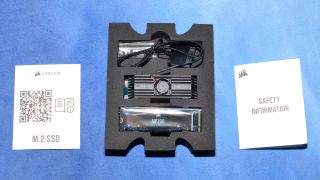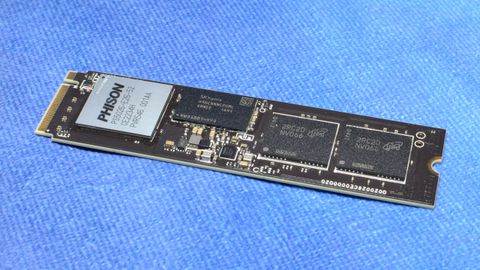Tom's Hardware Verdict
The Corsair MP700 is a fast, PCIe 5.0 NVMe SSD that brings enthusiast levels of storage performance to desktops. It exhibited no real downsides, but faster PCIe 5.0 SSDs are on the immediate horizon.
Pros
- +
The fastest sequential performance at retail, for now
- +
Good all-around and sustained performance
- +
Decent support and warranty
- +
DirectStorage firmware optimization
Cons
- -
Even faster drives are right around the corner
- -
Pricing still needs to come down a bit
- -
Performance advantages are for niche use
- -
Power efficiency is not great
Why you can trust Tom's Hardware
Editor's Note: Phison has released a new firmware update to address issues with its E26 controller. SSDs using this controller could perform poorly and crash if overheated, and the new update addresses these concerns. Updated testing results are on page 2 and updated conclusion on page 3.
One of the worst experiences you can have is to find yourself playing games or creating content on your PC only to have it suddenly lag and then shut off. Maybe your secondary SSD, hosting your games or assets, disappears from Windows Explorer. If you’re lucky, no data is lost, and a simple reboot gets you back into the action. If you’re unlucky, you might be spending the rest of the day trying to fix your machine, recovering your data, and figuring out what happened.
For this reason, reliability is usually the most important factor for a storage drive, but if it’s also a super high-end PCIe 5.0 SSD you are also expecting consistent, top-tier performance. These early adopter drives are expensive, so the initial rumors of the drives shutting down from overheating were paid a lot of attention. It didn’t apply to just one drive but rather to any using Phison’s E26, the first consumer 5.0 SSD controller on the market. Concerns were definitely overblown as it has always been recommended to run a heatsink with these drives, and they primarily only overheat when that advice is ignored.
Still, it’s better to have a more graceful throttling procedure, especially because performance would tank with the original firmware if the drive remained in an overheated state. Phison quickly addressed these issues with improved firmware that prevented shutdown and also kept performance at a higher level whenever the drive throttles. We’re testing that today to see how well a Corsair MP700 handles the throttling state, as the drive would fall flat on its face if pushed to the limit at launch without a heatsink. We must state again that these drives should not be run without a heatsink in daily use, so this issue isn't really an issue at all if the drive is used as intended.
Phison calls its approach “link-state thermal throttling,” which works in part by reducing the SSD’s link speed. This means reducing the negotiated speed from PCIe 5.0 to a lower level, such as 4.0 or 3.0. Capping performance at a lower level in this way will improve efficiency and reduce power draw, which in turn helps the drive equalize to a lower temperature. This is not just useful when the drive massively overheats, as is the case when it’s run without a heatsink, but also if it’s throttling closer to the edge. It’s worth updating the firmware if you’re always tempting a critical temperature.
This line of thinking is not new. Negotiating a slower link speed or link width, the latter referring to the number of lanes is a good way to throttle a PCIe device. Traditional throttling can involve the PCIe link but essentially relies on delaying I/O, which effectively reduces throughput. Phison’s approach for this controller is more consistent and attempts to avoid extra latency by not handling it at a higher layer. Running an SSD like the MP700 without a heatsink is an edge case outside of normal operating procedure, but having a safety net is a good thing, assuming it works.
Original Review published May 3, 2023:
They may be a little late, but the first crop of PCIe 5.0 SSDs have finally arrived at retail. The Corsair MP700 is one of the first models, and its leading-edge performance of 10GB/s of sequential read throughput and 1.7 million random write IOPS is a good indicator of what we can expect from the new wave of drives.
The MP700 is a flagship-class PCIe 5.0 NVMe SSD with good performance across the board, bringing enthusiast-class levels of storage performance to your desktop with high sequential bandwidth and all-around consistent performance. The drive also boasts good support from Corsair, a trusted name in SSDs.
The current crop of high-end PCIe 4.0 SSDs are still good enough for the majority of users, though, and are far cheaper. There are also faster 5.0 drives coming out this year. However, the MP700 is a good way to get into the PCIe 5.0 game and have DirectStorage-optimized firmware ready to go. Pricing is likely to come down quickly, but if you want the absolute fastest drive around, this is it for the time being. Let's take a closer look.
Specifications
| Product | 2TB |
|---|---|
| Pricing | $289.99 |
| Form Factor | M.2 2280 |
| Interface / Protocol | PCIe 5.0 x4 |
| Controller | Phison E26 |
| DRAM | LPDDR4 |
| Flash Memory | 232-Layer Micron TLC |
| Sequential Read | 10,000 MBps |
| Sequential Write | 9,500 MBps |
| Random Read | 1,500K |
| Random Write | 1,700K |
| Security | AES 256-bit |
| Endurance (TBW) | 1,400TB |
| Part Number | CSSD-F2000GBMP700 |
| Warranty | 5-Year |
The Corsair MP700 is designed for 2TB and carries an MSRP of $289.99. This is slightly higher than the current price of the Inland TD510, a similar drive that has seen its price decline more than once since it launched. This means that PCIe 5.0 drives are already becoming more affordable.
The MP700 is rated for up to 10,000 / 9,500 MBps for sequential reads and writes and up to 1,500K / 1,700K IOPS for random reads and writes. In addition, it’s backed by a five-year warranty that includes up to 1,400 TB of written data. Corsair claims AES-256 support, which could be misleading; however, the design of this controller is such that some manufacturers may choose to implement optional features.
Software and Accessories
Corsair offers a download for its SSD Toolbox software on its site. This application displays drive information and SMART health attributes, plus allows you to TRIM, clone, overprovision, or to securely erase the drive.
A Closer Look

We had no issue running this SSD without the fan, but your own high-end cooling solution, purchased separately or as part of your motherboard’s features, should be more elegant.
Corsair apparently agreed — the company had originally announced the drive with a cooler but changed course and decided to release this as a bare drive without the reference cooler. However, it’s important to note that the drive should not be run bare, or it will eventually throttle. We tested with our own motherboard’s heatsink and verified that this type of cooling is more than sufficient.


This drive has two NAND packages on either side, for a total of four, as well as a controller and a DRAM package on the front. You should take care to select a cooler that can handle a double-sided drive, but there are plenty of options on the market, not to mention possibly built right into your motherboard.
We can also see the indomitable Phison E26 PCIe 5.0 SSD controller. It's an eight-channel controller with a bus of up to 2400 MT/s for the NAND packages, which suggests it could hit up to 15,000 MBps. As configured, the MP700 is closer to 1600 MT/s and 10,000 MBps.
The E26 has the same optional I/O+ firmware optimizations as the E18, although currently that only applies to the Sabrent Rocket 4 Plus-G for PCIe 4.0 SSDs. These optimizations get the most out of DirectStorage and also improve sustained performance. The E26 is derived from an enterprise design, so this is a good match for sustained workloads, and it also has many more powerful but optional features.
The DRAM is Hynix H9HCNNNCPUMLCR-NEE, or LPDDR4. This is a low-power solution, and we saw some power savings with the even more efficient LPDDR4X on the Lexar Professional NM800 Pro. This is 32 Gb, or 4 GB, of DRAM, which is twice the expected amount. This was also the case with the reference design we previewed previously. There may be reasons for this decision, but we will have to test more E26 drives to get the full picture.
The NAND flash is labeled NV066, which is Micron TLC. This is its newest generation of flash at 232 layers, but it currently runs at 1600 MT/s for this drive. Peak rates will reach 2000 and 2400 MT/s with newer revisions.
Micron has gone from four to six planes with this design which helps improve performance due to greater internal parallelization. The flash dies used here are 1Tb or 128 GB each, so four dies in a QDP configuration for each of the four NAND packages. The use of denser dies means that SSDs can and will be able to reach higher capacities. Drives with 4TB of capacity should be common with the E26.
MORE: Best SSDs
MORE: Best External SSDs and Hard Drives
MORE: How We Test HDDs And SSDs
MORE: All SSD Content

Shane Downing is a Freelance Reviewer for Tom’s Hardware US, covering consumer storage hardware.

Corsair's Elite 6500 ATX and Elite 2500 Micro-ATX get accent panel options — removable panels available in wood and aluminum

Alleged Zen 5 'Strix Halo' Mobile APU has more GPU cores than RX 7600 XT or PS5 — features monster RDNA 3.5 GPU with 40 compute units

Grab this cool retro console inspired keyboard for just $83
-
emike09 Heat sink requirements on NVMe was bad enough, now we have an active fan and a SATA power cable to connect to it? Ugh. I'll stick to passive cooling. I don't need PCI-e 5 speeds, give me more capacity please! Where are affordable 4TB and 8TB drives? PCI-e 4.0 speeds are quite sufficient. I'm still running on PCI-e 3 drives and quite satisfied with professional apps and games load times.Reply -
Colif Reply
seems bot can't even link right articlemontss said:review link is broken
https://www.tomshardware.com/news/corsair-mp700-pcie5-ssd-video-leak
thats not it either. Something odd going on here. LInk it does show doesn't have drive.
All the reviews for it (apart from here) seem to 404. Maybe they accidentally revealed it again
Yep, they hid it again - https://www.guru3d.com/news-story/corsair-10gbs-mp700-pcie-gen5-ssd-got-unveiledbut-quickly-gets-hidden,6.html
Seems it does actually exist now - https://www.corsair.com/ww/en/Categories/Products/Storage/M-2-SSDs/MP700-PCIe-5-0-(Gen-5)-x4-NVMe-M-2-SSD/p/CSSD-F1000GBMP700R2
doesn't seem to have a fan on it in their shots, package contents doesn't mention it... I bet you pay more for it. -
newtechldtech I dont get the "brand name" part ... This is a Generic designed Phison Chip with Micron memory .... anything with the same chips will be the same regardless of the "brand"Reply -
Alphaswift Can we get the capacity increased? I'm tired for paying through the nose for just 2 TBReply -
Colif Reply
This one says up to 4tb - https://www.crucial.com/products/ssd/crucial-t700-ssd though it won't be cheap.Alphaswift said:Can we get the capacity increased? I'm tired for paying through the nose for just 2 TB
most of the results still show wrong drives, gen 4 instead of gen 5.
